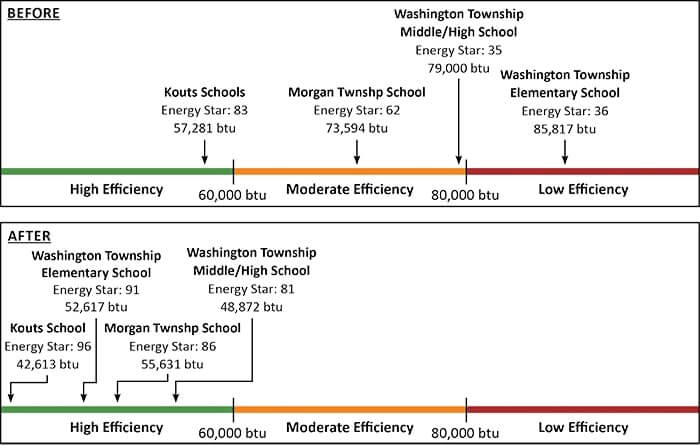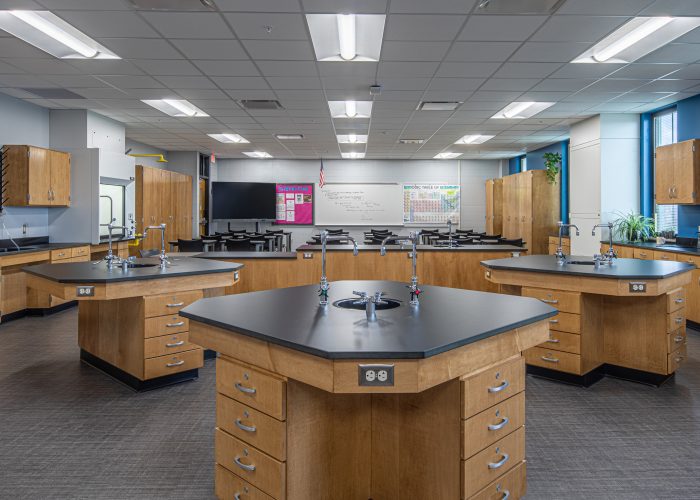Every day, new technology is being developed to make building energy systems more and more efficient. Energy efficient boilers and chillers, variable speed drives, and LED lighting can all be installed by schools as energy conservation measures. However, a system’s overall efficiency is just part of the story. Ultimately, the people operating the system and inhabiting the building determine how much energy is used. That’s why even after upgrading a building’s energy systems, it’s important to ensure that those energy systems are being operated efficiently and that the inhabitants of the building have changed any inefficient habits. K-12 school districts can reach their full energy savings potential if they are dedicated to changing behaviors and operations through Energy Leadership.
The East Porter County School Corporation Story
East Porter County School Corporation is a rural school district in Northwest Indiana that serves 2,500 students and is made up of four school buildings: Washington Township Elementary School, Washington Township Middle/High School, Kouts Schools (K-12), and Morgan Township Schools (K-12). East Porter County had previously taken steps to make its energy systems more efficient, but an analysis of each school building revealed that it had not achieved the dramatic energy cost savings the School Corporation desired. Seeking to improve their bottom line and achieve their true energy savings potential, East Porter County decided to pursue a full facility energy assessment.
After conducting a facility assessment and utility data analysis, engineers used the Energy Use Index (EUI) to rank the school buildings’ energy efficiency. The Energy Use Index (EUI) allows schools to understand if a building’s savings potential is being reached. The EUI is determined by how many BTUs (British Thermal Units) of energy a building uses per square foot. The BTUs per square foot are measured annually by looking at electric and gas bills. Buildings are then classified based on this measurement into three buckets: Low Efficiency, Moderate Efficiency, and High Efficiency. Three of East Porter County’s buildings fell in the Low Efficiency to Moderate Efficiency range and one was on the border of High Efficiency to Moderate Efficiency.
Baseline Energy Star® scores were also determined. The Energy Star score is a measure of how well a property is performing relative to similar properties when normalized for climate and operational characteristics. The 1-100 scale is set so that 1 represents the worst performing buildings and 100 represents the best performing buildings. A score of 75 or above indicates that a property may be eligible to earn the Energy Star label. Washington Township Elementary and Middle/High Schools had baseline Energy Star scores of 36 and 35 respectively. Morgan Township School had a baseline Energy Star score of 62 and Kouts Schools scored 83.
Guaranteed Energy Savings and Energy Leadership
Disappointed with the low-efficiency ratings and seeking the Energy Star symbol of excellence, East Porter County School Corporation implemented a guaranteed energy savings project coupled with an Energy Leadership Program to save as much as possible on utility bills. Along with saving energy costs, one of the main goals of the project was for each school building to earn the Energy Star label.
Washington Township Elementary School had the most energy savings opportunities. Rated Low Efficiency on the EUI with an Energy Star score of 36, the school suffered from discomfort in the classrooms including high humidity levels, overheating and overcooling, and poor lighting. The classroom environment was not conducive to learning or teaching. In order to improve the learning environment, the building received new efficient vertical unit ventilators in each classroom, new more efficient lighting, a high-efficiency boiler, and a controls upgrade. Other school buildings received high-efficiency boilers, new variable speed drives on motors, controls upgrades, roofing restorations and replacements, and direct drive units to replace old air handling units.

Making those mechanical improvements was helpful, but not good enough for East Porter County. In addition to installing energy conservation measures, East Porter County elected to increase its energy savings by introducing an Energy Leadership behavior-based energy savings program. The School Corporation hired Rebecca Juergens as energy manager to focus on operational efficiency and ensure that all buildings operated at its maximum efficiency potential.
“Including Energy Leadership in this project made a huge difference in our energy savings,” said Rod Gardin, Superintendent. “It held us to a higher level of responsibility, oversight, and follow-up that allowed East Porter County Schools to see savings above and beyond what a simple mechanical renovation would have achieved.”

Juergens implemented a corporation-wide student engagement program including a Jr. Energy Saver program, energy saving checklists, a classroom certification program, and an Energy Saver Logo Contest for middle school and high school students. This ensured corporation-wide involvement of students, teachers, and school administration in energy efficiency efforts.
“The Energy Leadership Program that has seen great receptivity from staff, students, and administration. With collaboration from all parties, East Porter County has been able to see significant energy savings of 29.4% (total BTU) district wide,” said Juergens.
Results
As a result of the combined guaranteed energy savings project and Energy Leadership program, East Porter County School Corporation saw a measured and verified first-year utility bill savings of $239,253 across all buildings. Washington Township Elementary School became 39% more efficient, and even Kouts School, the most efficient building in the corporation before improvements, became 25% more efficient. Now, all buildings in the school corporation have earned the Energy Star label.

“We have a responsibility to use public tax dollars wisely, and the energy savings upgrades along with our Energy Leadership Program saved us over $239,000 in energy costs last year,” said Gardin. “Not only that, but we improved our children’s learning environment as well. The change is significant: the schools are cleaner and quieter and the air quality has dramatically improved. This was a true ‘win’ for East Porter County.”
East Porter County School Corporation was able to optimize its energy savings dollars by implementing an Energy Leadership Program in conjunction with their guaranteed energy savings project. Addressing both equipment upgrades through energy conservation measures and changing behavioral habits ensured that the school got the most out of its guaranteed energy savings project.
“As leaders in our community, we have a responsibility to be good stewards of our resources, and schools are no exception,” said Juergens. “By changing our behaviors to make our schools more energy efficient, we are able to give back to our community, and most importantly, to the students we work with every day.”







